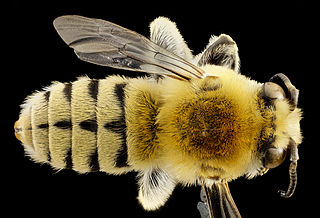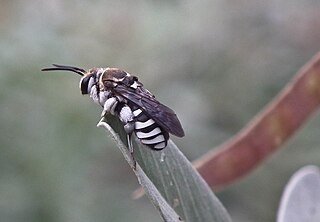
Carpenter bees are species in the genus Xylocopa of the subfamily Xylocopinae. The genus includes some 500 bees in 31 subgenera. The common name "carpenter bee" derives from their nesting behavior; nearly all species burrow into hard plant material such as dead wood or bamboo. The main exceptions are species in the subgenus Proxylocopa; they dig nesting tunnels in suitable soil.

The cosmopolitan bee genus Ceratina, often referred to as small carpenter bees, is the sole lineage of the tribe Ceratinini, and is not closely related to the more familiar carpenter bees. The genus presently contains over 300 species in 23 subgenera. They make nests in dead wood, stems, or pith, and while many are solitary, a number are subsocial, with mothers caring for their larvae, and in a few cases where multiple females are found in a single nest, daughters or sisters may form very small, weakly eusocial colonies. One species is unique for having both social and asocial populations, Ceratina australensis, which exhibits all of the pre-adaptations for successful group living. This species is socially polymorphic with both solitary and social nests collected in sympatry. Social colonies in that species consist of two foundresses, one contributing both foraging and reproductive effort and the second which remains at the nest as a passive guard. Cooperative nesting provides no overt reproductive benefits over solitary nesting in this population, although brood survival tends to be greater in social colonies. Maternal longevity, subsociality and bivoltine nesting phenology in this species favour colony formation, while dispersal habits and offspring longevity may inhibit more frequent social nesting in this and other ceratinines.

In biology, Lipotriches is a large genus of sweat bees in the family Halictidae, distributed widely throughout the Eastern Hemisphere though absent from Europe. There are nearly 200 species in 9 subgenera. They commonly have prominent bands of hair on the margins of the metasomal segments.

Crossotus is a genus of longhorn beetles of the subfamily Lamiinae.

Epeolus is a genus of cuckoo bees in the family Apidae. They are often known as variegated cuckoo-bees.

Anthidiini is a tribe of insects in the family Megachilidae. There are at least 40 genera and 840 described species in Anthidiini. There is strong evidence that the tribe is monophyletic.

Habropoda is a genus of anthophorine bees in the family Apidae. There are at least 50 described species in Habropoda.

Ashmeadiella is a genus of bees in the family Megachilidae. There are more than 60 described species in Ashmeadiella.

Anthidiellum is a genus of rotund resin bees in the family Megachilidae. There are more than 60 described species in Anthidiellum.

Panurginus is a genus of bees in the family Andrenidae. There are more than 50 described species in Panurginus.
The following is a taxonomy of extant (living) Brachiopoda by Emig, Bitner & Álvarez (2019). There are over 400 living species and over 120 living genera of brachiopods classified within 3 classes and 5 orders, listed below. Extinct groups are not listed.

Ammobates is a genus of cuckoo bees belonging to the family Apidae.

Pseudapis is a genus of bees belonging to the family Halictidae.
Pasites is a genus of cuckoo bees belonging to the family Apidae.

Dioxyini is a tribe of cuckoo bees in the family Megachilidae. There are eight genera in Dioxyini, comprising 36 species.













